As many readers know, nearly all electrical power transmission lines are three-phase AC (alternating current). When you look up at one of the towers, you see three (or a multiple of three) transmission conductors. In the US there are are only a few direct-current (DC) transmission lines. One of them is called Path 27. I first read about Path 27 about seventeen years ago, when I was writing the patent application that became US patent number 8183714. Recently I was able to do something that I had wanted to do for a very long time — I visited one of the massive ground electrodes for Path 27.
By way of background, almost all transmission lines in the US and elsewhere in the world are three-phase AC lines. The transmission lines provide interconnection between service areas. Some transmission lines go hundreds of miles. Decades ago the first transmission lines were AC, mostly because it is extremely easy to “step up” or “step down” the AC voltage using simple and relatively inexpensive electrical transformers.
One of the important design aspects of an AC transmission line is that the phase of the AC power being delivered to a destination service area must somehow be made to match exactly the existing phase of the electrical power in that service area.
Only a small handful transmission lines in the US employ DC rather than AC. In the early days of long-distance electrical power transmission, it was very difficult and expensive to go back and forth between high power DC and high power AC. This prompted the designers of long-distance transmission lines to use only AC in those early days.
Starting in about 1970, baby steps began in the US in the direction of trying to figure out how to use DC in long-distance transmission lines. The fourth attempt in the US happened in 1986, and it became what is now known as Path 27.
The concept and goals for Path 27 were simple: figure out a way to burn massive amounts of coal to make massive amounts of electricity for the Los Angeles metropolitan area, while ensuring that the people in the Los Angeles metropolitan area would never need to inhale the smoke from the power plant. The solution? Put the power plant 488 miles away in Utah, so that the smoke would be inhaled by people in Utah instead of California.
The 488-mile transmission line, if constructed using the very familiar and well-understood AC type of line, would have required three expensive conductors, each 488 miles long. If the relatively new and less-well-understood DC type of line were used, only two expensive conductors (again, each 488 miles in length) would be required. And so the decisionmakers decided to take a walk on the wild side and use an HVDC (high voltage direct current) transmission line.
When coal is burned to generate electrical power, it gets generated as AC power. It is a pretty straightforward matter to convert AC power into DC power, using relatively simple and well-understood rectifiers (diodes). This happens at the Delta plant in Utah.
At the other end of Path 27 there is a facility called the Adelanto Converter Station, located between Barstow and Los Angeles. It is in this station that the expensive and tricky business of converting the DC power back into AC power takes place. As mentioned above, one of the tricky things was making sure that the phase of the newly created AC power is an exact match to the phase of the existing electricity that is in the grid into which the AC power is being injected.
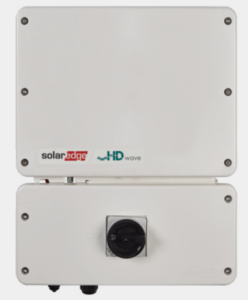
Tricky? I talk about the phase synchronization as being tricky. Actually, by now in 2023 this phase synchronization happens routinely in many systems. Tens of millions of homes in the US have solar panels that are connected to the local electrical grid in a way that pumps electrical power “into the grid” whenever the solar panels make an amount of energy that is more than the house itself needs. Each such house has one or more inverters like the one shown at right. Each inverter pretty much effortlessly converts DC to AC in such a way that the AC power has a phase that is a perfect match for the AC power that is already in the local grid. We might say that the inverter is a “phase follower”.

Yet another example of AC phase synchronization arises when a house has battery storage such as one or more Tesla Powerwalls, shown at right. When the Powerwall faces the need to generate AC power, usually it is a “phase follower”. But every now and then, the reason for the Powerwall being called into service is that the power supplied to the house from the electrical grid has failed. When that happens, the Powerwall switches from being a “phase follower” to being a “phase leader”. Later when the power from the grid to the house is restored, the Powerwall switches seamlessly back into being a “phase follower”, matching its generated AC phase to the phase detected in the grid.
In 1970, or in 1986, it was no easy thing to convert massive amounts of DC electric power into AC electric power, while ensuring that the phase of the newly generated AC electric power was a perfect match to the phase of the AC power already present in the transmission grid at the point of interconnection.
Now we get to one more bit of background for DC transmission lines. The simple (well, relatively simple) approach for transmitting DC power over a long distance would be to use two conductors . One would be the outbound (call it positive) path from the power plant to the distant end of the transmission line, and the other would be the return (call it negative) path back to the power plant.
Designers of DC transmission lines, however, give themselves a further goal, namely designing the system so that even if one of the two conductors in the HVDC transmission line were to fail, there would still be a way to use the remaining conductor to deliver DC power. The answer, remarkably, is to use the Earth itself as the return path.
It turns out that this same trick of using the Earth as an electrical conductor has for many decades been done for AC transmission lines. This trick, which is called SWER (single-wire earth return, Wikipedia article), is used in many rural areas (most notably in Australia and New Zealand) because it saves lots of money for conductors and insulators along the path of the transmission line.
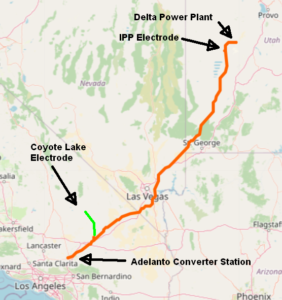
We are now in a position to show Path 27 on a map, showing points of interest. At upper right is the coal-burning power plant, called the “Delta plant”. At lower left is the Adelante Converter Station, where the DC power gets converted to AC power and injected into the transmission grid near Los Angeles. These two points are connected by the Path 27 DC transmission line, shown in orange.
This now brings us to the idea of using the Earth itself as one of the DC conductors in the event of failure of one of the conductors in the DC transmission line. To do this, the designers of Path 27 provided for two ground electrodes. A first ground electrode, called the “IPP Electrode” on this map, is seen at upper right. The second ground electrode, called the “Coyote Lake Electrode” on this map, appears at the lower left.
It is, apparently, not easy for system designers to pick a good place for such a ground electrode. I would have thought you would simply place the electrode very close to the end of the transmission line. For example I would have thought you would place the ground electrode for the Adelante Converter Station directly beneath that station. Nope! The designers get nervous, I guess, about what might happen underground when some massive DC electrical current gets injected into the ground or extracted from the ground. They figure that if there were, for example, a buried metal pipe such as a natural-gas pipeline or water line that happened to lie along the underground path between the two ground electrodes, such a pipe might end up serving as some or all of the DC conductor instead of the Earth itself. The way to duck this is to pick a place for the ground electrode that is (hopefully) not nearby to existing human-caused things like metal pipelines. The Coyote Lake Electrode is about 38 miles distant from the Adelante station.
A further aspect of picking a place for the ground electrode is that one wants to pick a place where the Earth is more electrically conductive rather than less electrically conductive.
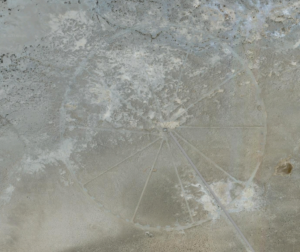
Which brings us to the Coyote Lake Ground Electrode. This electrode lies, oddly enough, in a dried lakebed of what was once called Coyote Lake. A satellite photo of the electrode may be seen at right. The ground line from the Adelante station enters this view at the lower right. The ground line (which is a buried line in the area shown here) proceeds toward the upper left, reaching a node at the center of the circle. The circle is about 3000 feet in diameter. Ten “spokes” may be seen in the satellite photo, each of which is a buried wire extending from the central node to a point on the circle. The spokes are buried wires, and a buried wire defines the circle itself. At each of sixty points around this circle, a rod extends about 200 feet into the ground. This circular buried structure was the target of the pilgrimage that I refer to in the title of this blog article.

We can now return to the Path-27 map shown again at right. The orange line, it will be recalled, is the two-conductor HVDC transmission line, 488 miles in length. Two more ground conductors start at the Adelante station at lower left, and are strung along the tops of the transmission-line towers, proceeding toward the northeast toward Coyote Lake. For the last few miles the two ground conductors diverge from the orange HVDC line and proceed straight north (shown in green on the satellite photo) and then angle slightly to the northwest, arriving at the center of the circle that defines the Coyote Lake Electrode.
It turns out that anybody who wishes to do so can visit and walk around upon this Coyote Lake Electrode.
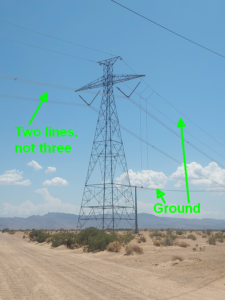
You approach on Interstate Highway 15, exiting at Harvard, California. You drive on gravel roads, starting out on Hacienda Road, then to an intersection with Bragdon Road. It is here that you see the HVDC transmission line of Path 27. In this view the Adelante station is to the right, some 38 miles distant. The Delta plant is to the left in this photograph, some 450 miles distant. The two ground wires from the Adelante station come into view from the right. The two ground wires drop down to shorter poles and head north, which is to the lower right in this photograph.
The most striking thing about the transmission tower that appears in this photograph is that it has two conductors rather than the usual three conductors,
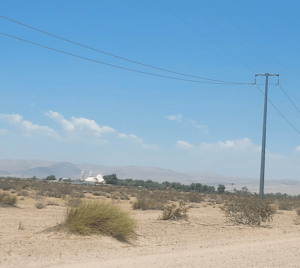
You then proceed northward on Bragdon road. After a while you jog slightly to the right onto Coyote Lake Road, proceeding further northward in the direction of the Saint Antony Christian Coptic Orthodox Monastery (web site), which is the white structure in the distance. In the foreground we can see part of the two-conductor ground line that was shown in green in the previous map.
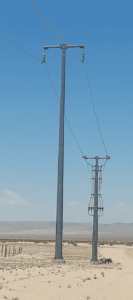
You go past the monastery and you soon encounter a place (photo at right) where the two-conductor ground line goes underground and continues to proceed northward toward Coyote Lake. You eventually reach what is marked as, and appears to be, the end of the road.

Persistence reveals a slight jog to the west as an unmarked Coyote Lake Road proceeds further northwards. Eventually the road (and the buried ground line) turn slightly to the northwest, eventually reaching the center of the electrode, shown again in satellite view at right.
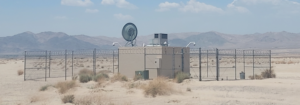
As you proceed northwest on this unpaved road, you draw near to a fenced area with a monitoring station inside (shown at right).
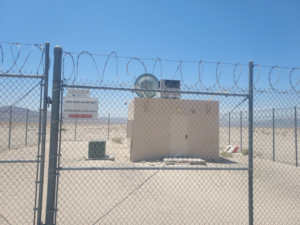
At the fenced area there is signage saying that this is the “Coyote Ground Electrode Facility” of the “Intermountain Power Authority”.
As mentioned earlier, nearly everything that makes up this electrode is buried. The ground line that approaches from the south, along the gravel road, is buried for the last three miles. The ten spokes that each extend 1500 feet from this monitoring station out to the circular path are buried. The circular path, 3000 feet in diameter, is itself buried, as are the sixty electrodes that each extend 200 feet downwards.
Readers who are amateur radio operators will recognize that this electrode is functionally the same as the “counterpoise” electrode that is used at the base of a high-power monopole antenna.
During this visit, one could pause to consider that at times, a gigawatt of electricity is being pumped into the ground, or perhaps extracted from the ground, at this location. As may be appreciated from the satellite photo, nearly everything about the electrode is out of view, buried underground. But perhaps one could absorb some kind of energy just by being there. Maybe one could also draw some contemplative inspiration by being nearby to the Saint Antony Christian Coptic Orthodox Monastery.

Hi Carl,
Great article. I’m very much aware of Path 27 and it’s 2 ground rings yet I haven’t been to either. I live in Los Angeles and go by Coyote all the time but just haven’t stopped in. I’ve entered them on by Google Earth maps of the LADWP microwave system. Plus I’ve been to Lane Mtn where the microwave dish is pointing.
Funny my brother did probably some 20 years and while he was at the building 2 guys showed up saying they were with LADWP and he needed to leave.
You wouldn’t happen to have such a fine article on Path 65 would you? I’ve entered that system on my GE map also. I read about and seen photos of the grounding array in Santa Monica bay. Fascinating array of underwater electrodes. I’ve pretty much followed the ground lines on tops of towers from SM to the converter station in Sylmar. I have not been able to find the ground ring at the north end near The Dalles OR. I found some Lat/Long coordinates and have gone around and round that area with no luck. I can see on Google View where the ground lines drop down but still no luck going out from there. It’s low rolling hills & looks like used for grazing.
Thank you for your time and again a great article. I’ve forwarded it to a couple friends.
Ken Rice
Anaheim